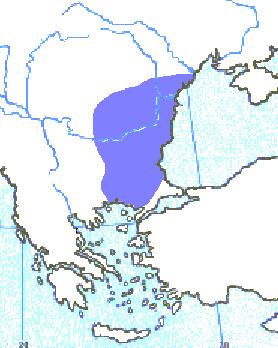 | ||
Dates circa 4,700 B.C.E. — circa 3,950 B.C.E. | ||
Geography
At its full extent the culture extended along the Black Sea coast to central Bulgaria and into Thrace. The aggregate "Kodjadermen-Gumelnita-Karanovo VI" evolves out of the earlier Boian, Marita and Karanovo V cultures. It is supplanted by Cernavodă I in the early 4th millennium.
Contents
- Geography
- Periodization
- Gumelnia A
- Gumelnia A1
- Gumelnia A2
- Synchronisms
- Culture
- Technological developments
- Danube Script
- References
Periodization
One of the most flourishing civilizations from the last half of the 5th millenium [sic] BC is (next to the Ariuşd Cucuteni – Tripolie complex) Gumelniţa Culture... absolute chronology, still under discussion, according to the latest calibrated data, assigns this culture (as mentioned above) to the limits of the last half of the 5th millenium [sic] BC and maybe to early 4th millenium [sic] BC.
—Silvia Marinescu-Bîlcu, "Gumelniţa Culture"The first periodization of Gumelnita culture was suggested by VI. Dumitrescu who split the civilization of Gumelniţa into two phases: A and B. Later on, Dinu V. Rosetti divided the civilization into Al, A2 and B1, B2.
Gumelniţa A
With a centric evolution from geographic point of view, the intensity of the cultural trends decreased from the center towards peripheral area. Having a strong Boian background at the origins, mixed with Maritza elements, the Gumelnita culture has been lasted short of a millennium from the beginning of Charcolitic to the start of the fifth millennium.
Gumelniţa A1
4700-4350 Gumelnita-Karanovo VI-Kodjadermen is also aggregated with Varna culture, still are debates along historians considering the distinctive character of Varna culture.
Gumelniţa A2
4500-3950 The regional characteristics of A1 phase are diminished, and a more uniform characteristics is identified in discovered artifacts.
Synchronisms
The evolution of the Gumelniţa-Kodjadermen-Karanovo VI is ended on the north bank of the Danube after the arrival of Cernavoda cultures population.
The layers at Karanovo are employed as a chronological system for Balkans prehistory.
Culture
The Gumelniţa is remarkable by the richness of its anthropomorphic and zoomorphic representations. Some consider the achievements of prehistoric craftsmen to be true masterpieces.
The representation from Gumelnița art differ by other cultures by the following:
As evidence from archaeology, thousands of artifacts from Neolithic Europe have been discovered, mostly in the form of female figurines. As a result a goddess theory has occurred. The leading historian was Marija Gimbutas, still this interpretation is a subject of great controversy in archaeology due to her many inferences about the symbols on artifacts.
Technological developments
Gumelniţa culture has some sign of work specialisation:
...we do not have enough data on the internal organization of the community, but next to the dwellings themselves, arranged or not in a certain order, we encounter workshop-dwellings for processing lithic material, bones, horns, ornaments, statuettes, etc.).
—Gumelniţa Culture by Silvia Marinescu-BîlcuDanube Script
During the Middle Copper Age, the Danube script appears in three horizons: The Karanovo VI–Gumelniţa–Kodžadermen cultural complex (mainly in Bulgaria, but also in Romania), the Cucuteni A3-A4–Trypillya B (in Ukraine), and Coțofeni I (in Serbia). The first, rates 68.6% of the frequencies; the second, rates 24.2%; and the third, rates 7.6%.
